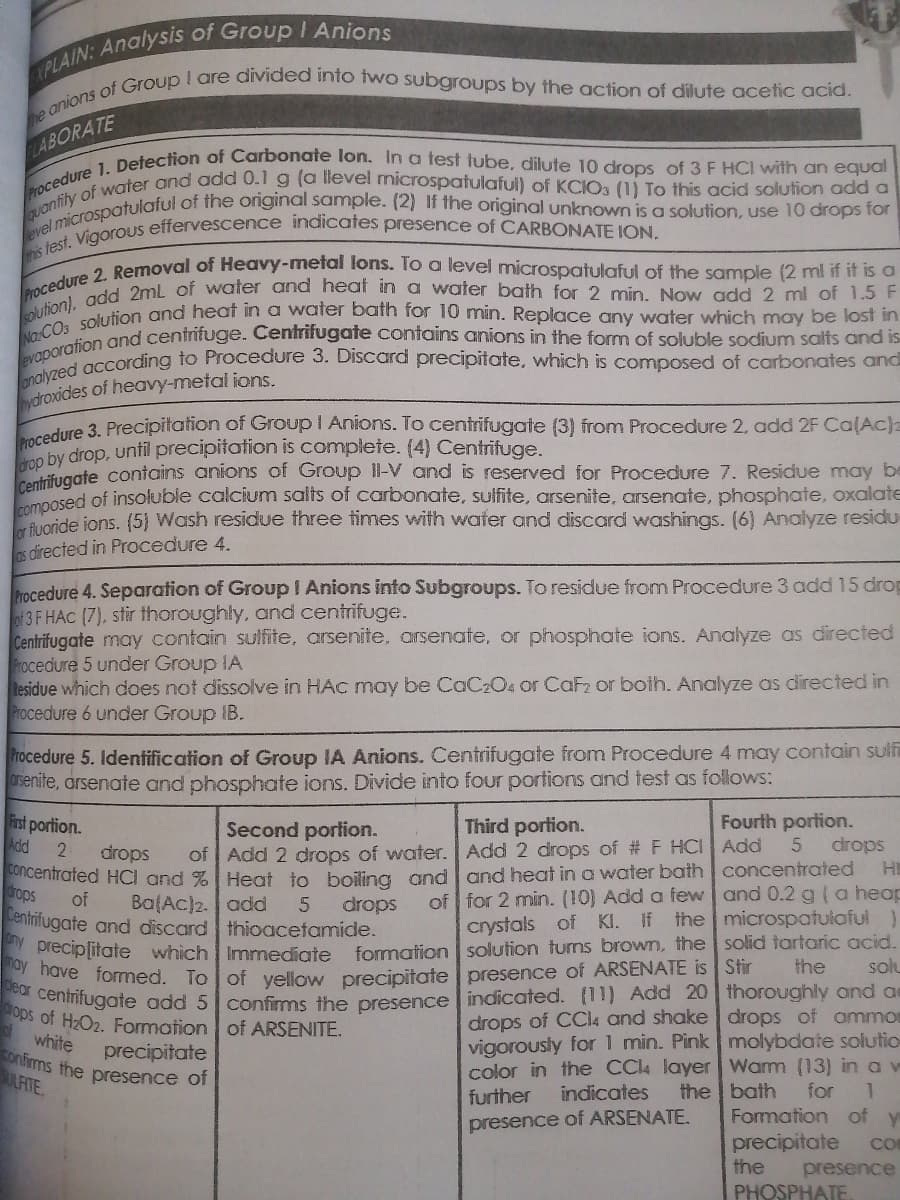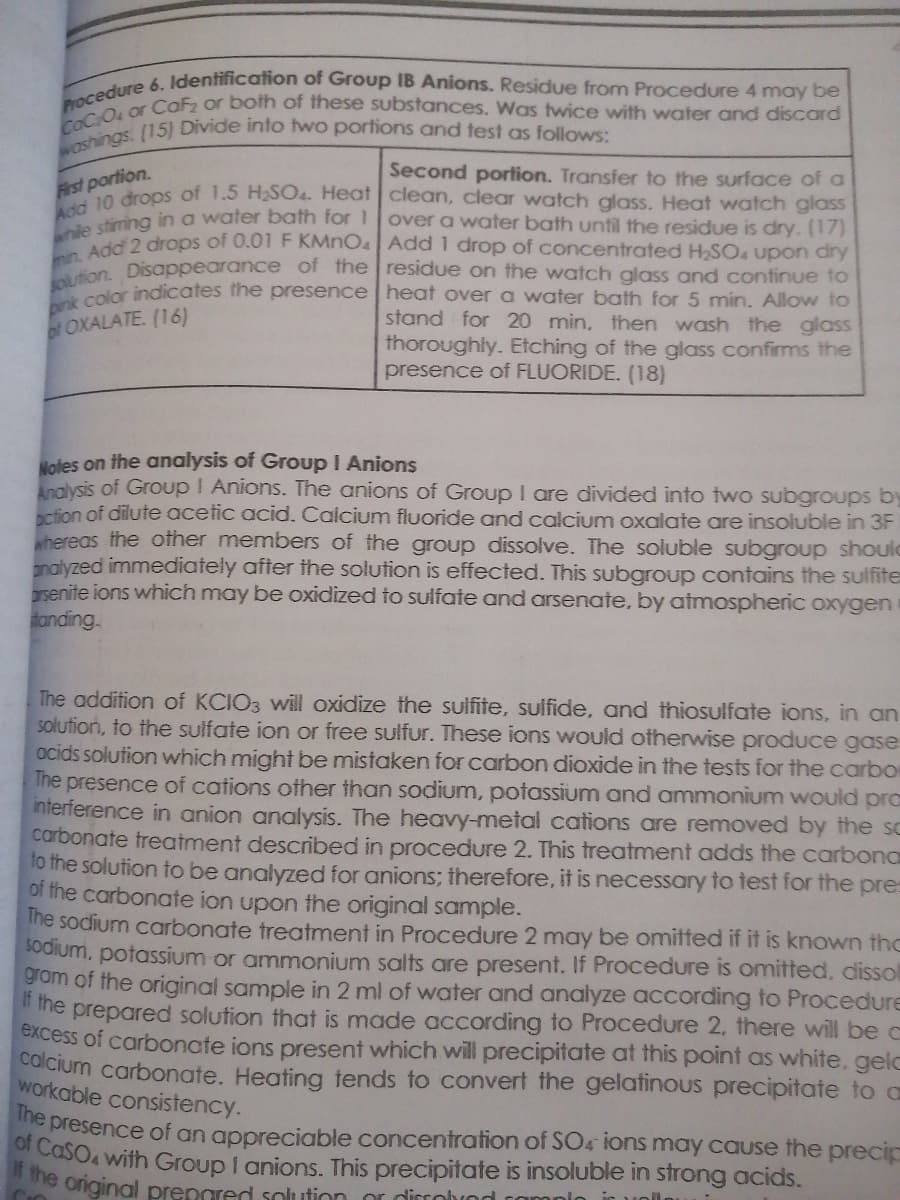Chapter16: Applications Of Neutralization Titrations
Section: Chapter Questions
Problem 16.40QAP
Related questions
Question
Explain or Give conclusions abput the precipitation, identification and separation of Group I ANIONS

Transcribed Image Text:ABORATE
droxides of heavy-metal ions.
cedure 3. Precipitation of Group I Anions. To centrifugate (3) from Procedure 2. add 2F Ca(Ac)2
Dy drop, until precipitation is complete. (4) Centrifuge.
ontifugate contains anions of Group Il-V and is reserved for Procedure 7. Residue may be
eesed of insoluble calcium salts of carbonate, sulfite, arsenite, arsenate, phosphate, oxalate
fuoride ions. (5) Wash residue three fimes with water and discard washings. (6) Analyze residu
s directed in Procedure 4.
rocedure 4. Separation of Group I Anions into Subgroups. To residue from Procedure 3 add 15 drop
of 3 F HAC (7), stir thoroughly, and centrifuge.
Centrifugate may contain sulfite, arsenite, arsenate, or phosphate ions. Analyze as directed
Procedure 5 under Group IA
lesidue which does not dissolve in HAC may be CaC2O4 or CaF2 or both. Analyze as directed in
Procedure 6 under Group IB.
rocedure 5. Idenfification of Group IA Anions. Centrifugate from Procedure 4 may contain sulfi
arsenite, arsenate and phosphate ions. Divide into four portions and test as follows:
Fist portion.
Add
Fourth portion.
drops
H
Third portion.
Second porlion.
of Add 2 drops of water. Add 2 drops of # F HCI Add
drops
water bath concentrated
of for 2 min. (10) Add a few and 0.2g(a heap
crystals of KI. If the microspatulaful
preciplitate which Immediate formation solution tums brown, the solid tartaric acid.
Concentrated HCI and % Heat to boiling and and heat in
drops
of
Ba(Ac)2. add
drops
Lentrifugate and discard thioacetamide.
the
sou
fnave fomed. To of vellow precipitate presence of ARSENATE is Sfir
ops of H2O2. Formation of ARSENITE.
white
onfims the presence of
ULFITE
o cenmfugate add 5 confirms the presence indicated. (11) Add 20 thoroughly and ae
drops of CClk and shake drops of ammon
vigorously for 1 min. Pink molybdate solutio
color in the CCl4 layer Warm (13) in a w
precipitate
further
indicates
the bath
for
Formation of y
precipitate
the
PHOSPHATE
presence of ARSENATE.
co
presence

Transcribed Image Text:washings. (15) Divide into two portions and test as follows:
COCO or Caf2 or both of these substances. Was twice with water and discard
Procedure 6. Identification of Group IB Anions. Residue from Procedure 4 may be
jolution. Disappearance of the residue on the watch glass and continue to
Add 10 drops of 1.5 H2SO4. Heat clean, clear watch glass. Heat watch glass
min. Add 2 drops of 0.01 F KMNO4 Add 1 drop of concentrated H2SO4 upon dry
while stiming in a water bath for 1 over a water bath until the residue is dry. (17)
If the original prengrend solution or dirrohund ramnin
Second portion. Transfer to the surface of a
First portion.
lor indicates the presence heat over a water bath for 5 min, Allow to
stand for 20 min, then wash the glass
of OXALATE. (16)
thoroughly. Etching of the glass confirms the
presence of FLUORIDE. (18)
Noles on the analysis of Group I Anions
nglysis of Group I Anions. The anions of Group I are divided into two subgroups by
ction of dilute acetic acid. Calcium fluoride and calcium oxalate are insoluble in 3F
hereas the other members of the group dissolve. The soluble subgroup should
analyzed immediately after the solution is effected. This subgroup contains the sulfite
senite ions which may be oxidized to sulfate and arsenate, by atmospheric oxygen
anding.
The addition of KCIO3 will oxidize the sulfite, sulfide, and thiosulfate ions, in an
solution, to the sulfate ion or free sulfur. These ions would otherwise produce gase
acids solution which might be mistaken for carbon dioxide in the tests for the carbor
The presence of cations other than sodium, potassium and ammonium would pra
interference in anion analysis. The heavy-metal cations are removed by the sc
carbonate treatment described in procedure 2. This treatment adds the carbona
1o the solution to be analyzed for anions; therefore, it is necessary to test for the pres
of the carbonate ion upon the original sample.
The sodium carbonate treatment in Procedure 2 may be omitted if it is known the
Sodium, potassium or ammonium salts are present. If Procedure is omitted, dissol
g'ớm of the original sample in 2 ml of water and analyze according to Procedure
"Ihe prepared solution that is made according to Procedure 2, there will be c
excess of carbonate ions present which will precipitate at this point as white, gelc
calcium carbonate. Heating tends to convert the gelatinous precipitate to a
workable consistency.
e presence of an appreciable concentration of SO4 ions may cause the precip
asO, with Group I anions. This precipitate is insoluble in strong acids.
Expert Solution
This question has been solved!
Explore an expertly crafted, step-by-step solution for a thorough understanding of key concepts.
Step by step
Solved in 3 steps with 23 images

Knowledge Booster
Learn more about
Need a deep-dive on the concept behind this application? Look no further. Learn more about this topic, chemistry and related others by exploring similar questions and additional content below.Recommended textbooks for you


Chemical Principles in the Laboratory
Chemistry
ISBN:
9781305264434
Author:
Emil Slowinski, Wayne C. Wolsey, Robert Rossi
Publisher:
Brooks Cole

Chemistry: Principles and Reactions
Chemistry
ISBN:
9781305079373
Author:
William L. Masterton, Cecile N. Hurley
Publisher:
Cengage Learning


Chemical Principles in the Laboratory
Chemistry
ISBN:
9781305264434
Author:
Emil Slowinski, Wayne C. Wolsey, Robert Rossi
Publisher:
Brooks Cole

Chemistry: Principles and Reactions
Chemistry
ISBN:
9781305079373
Author:
William L. Masterton, Cecile N. Hurley
Publisher:
Cengage Learning